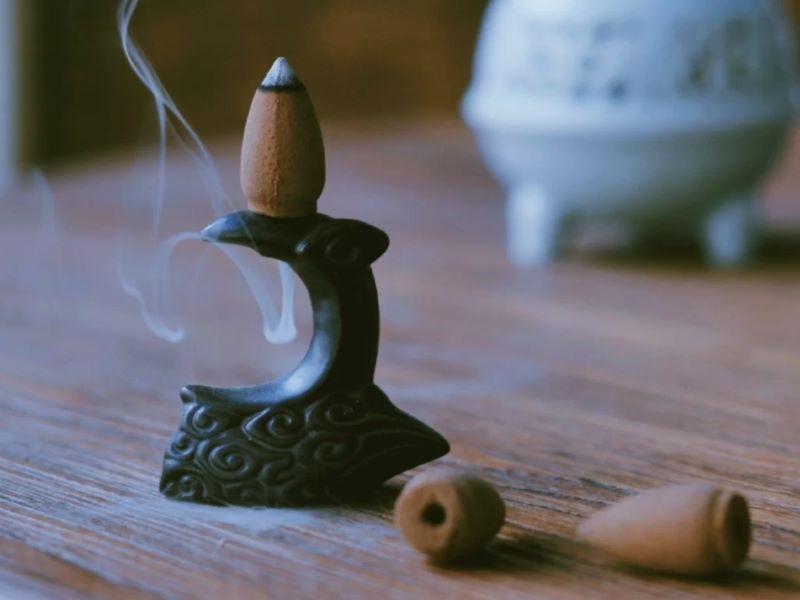Some people confuse backflow cones with regular incense cones, but they’re not the same.
A distinct difference between them is that backflow incense cones have a hollow tunnel, which causes smoke to flow in the opposite direction.
Keep reading to learn eight additional things you need to know about backflow cones, starting with how they work.

1. How Do Backflow Incense Cones Work?
There’s a small hole that hollows out backflow incense cones and causes its smoke to flow downwards instead of upwards. This creates a calming visual effect when placed on a backflow incense burner.
Smoke is a mixture of gas and the tiny particles, or soot, that are released from plant matter when incense is burned. Typically, the more soot, the more visible the smoke. That’s until there’s a shift in temperature.
Warm incense smoke travels up because it’s lighter than air. But with backflow cones, warm air cools as it travels down the tunnel and out of the small hole at the base of the cone. As the smoke continues to cool, it thickens, becomes more visible, and sinks down. This is the magical thick smoke seen flowing down backflow burners.
But you might also be wondering how to light them in order to experience the cool smoke flow.
How to Light Backflow Incense Cones:
It can take a little longer for backflow cones to release smoke. So lighting backflow cones may require more patience in comparison to lighting regular incense cones.
- While firmly holding the cone, light the tip and allow it to burn for a few seconds. Gently blow out the flame. You should see the tip glow.
- At this point, keep an eye on the base of the cone. Smoke will begin to travel down through its hollowed center. If this doesn’t happen after a few seconds, then you’ll want to start the process over again.
- Once the smoke does begin to flow downward, place the cone at the top of your backflow burner. Usually, there’s a specific location for you to sit the backflow cone. Make sure that you align both the burner and cone holes to fully experience the smoke effects.
2. What Are Backflow Incense Cones Made Of?
The same ingredients that are used to make conventional incense cones are used to create backflow ones.
A powder is formed from plant matter like tree barks, flower petals, seeds, resin, and roots. Additional fragrance is often added from essential oils and/or fragrance oils. And there’s typically a binder, like honey, a soft resin, or gum arabic, that holds all of the ingredients together. The mixture is then pressed into conical shapes and left to dry.
Because incense cones are not made with a bamboo core like some incense sticks are, you won’t smell wood burning. You will only smell its fragrant ingredients when burned. And the scent is usually stronger because you’re burning highly concentrated, compressed ingredients.
3. How Long Do Backflow Incense Cones Burn?
Burn time varies by cone size and ingredients. Backflow incense cones can burn anywhere from ten minutes up to thirty minutes or more.
Here are three examples:
| Brand | Size | Burn Time |
| HEM Lavender Backflow Incense Cones | 1.5 inches | 40 minutes |
| NAQSH Backflow Cones Assortment | 1.5 inches | 15-20 minutes |
| Satya SuperHit Backflow Cones | 2 inches | 15-20 minutes |
As you can see when comparing HEM with NAQSH, burn time can vary even when cones are the same height.
4. Are Backflow Incense Cones Safe?
It is safe to inhale any incense smoke, in moderation, when the incense ingredients are not artificial.
Exposure to excess smoke on a frequent basis can lead to health problems. But of the smoke isn’t directly in your face, and you aren’t inhaling toxins from synthetic ingredients, you don’t have anything to worry about unless you have a pre-existing health condition that makes smoke inhalation problematic. In such cases, it’s best to speak to a medical professional about exposure to incense smoke.
If you have pets, you will want to speak to your veterinarian before burning backflow incense at home. Pets, especially cats, have more sensitive respiratory systems than humans do, so it wouldn’t hurt to check in with your pet’s doctor first.
Otherwise, it is actually more helpful than harmful to burn incense cones that are made using plant matter without any chemicals.
Burning different types of incense cones can help:
- Improve concentration
- Fight infections
- Stress relief
- Alleviate of symptoms related to depression and anxiety
- Create a soothing atmosphere
Not to mention the visual effects of watching smoke travel from backflow cones. Beyond being mindful of backflow cones ingredients, you’re the greatest determining factor in ensuring that you’re safely using them.
In order to get the best burn experience out of your cones, it’s important to put precautions in place:
- Always place your incense burner on a heat-resistant surface.
- Never light your incense cones, and then leave them unattended. This can create a fire hazard.
- On a related note, always burn incense away from any kind of hanging materials – drapes, apparel – or any flammable materials.
- Try not to move your burner once the incense is lit. Both the burner, ash, and smoldering incense cone might all be too hot to the touch.
- If you have children and/or pets, make sure to supervise them when burning incense. Avoid injuries by not allowing them to get too close. Also consider the incense ingredients and whether they can be burned in their presence.
- Always allow everything to cool down before discarding the ashes or handling the burner.
5. Why Do Backflow Incense Cones Smell Bad?
When made with plant compounds and natural fragrance extracts, backflow cones do not smell bad.
The ones that smell bad are made with synthetic ingredients. Unfortunately, many of the bonus cones that are provided for free with purchase of a backflow incense burner or made with low quality ingredients.
But I should mention that not all synthetic ingredients are of low quality. For instance, Wild Berry uses highly concentrated fragrances produced in a lab, but their customers love how their incense smells! Their incense is charcoal-based, but they don’t use any toxic ingredients. Dragon’s Blood and Fizzy Pop are two of Wild Berry customers’ favorite backflow incense cone fragrances.
If you want to find backflow incense cones that smell good, you have to search beyond the ones that are included with your burner. I would also stay away from colorful incense cones because they are often made using inferior ingredients.
In addition to Wild Berry, HEM and Satya make non-toxic backflow incense cones.
6. Are All Incense Cones Backflow?
Only incense cones with the visible hole in their base and up through the center are backflow incense cones.
Conventional incense cones have a flat base without a hole. If you are looking for the downward flowing smoke effect, you can only experience this using incense cones that are labeled, “backflow.”
7. Can You Make Regular Incense Cones Backflow?
This process requires some trial and error, but creating your own backflow incense cones from the traditional cones you have on hand is possible. Just note that the process requires time and patience in order to avoid destroying the cone altogether.
Since pre-made cones are hard and not pliable, you would need to use an electrical or battery-powered drill to make a hole. Using a fine drill bit that’s 1/16” (1mm), you can make a hole through the bottom of your incense cone. Make sure you stop drilling about ¼” to ⅛” from the tip of the cone. Slow and steady wins the race here as too much force will cause the cone to fall apart.
It can take a few minutes to carefully drill one cone. For some it is not worth the time investment, but that’s up to you. It could be a fun DIY project.
After drilling the holes, you would light the cones as described above to witness the backflow effects.
8. Can You Make Your Own Backflow Incense Cones?
If you want to make your own backflow incense cones, there are a couple ways to do that.
- You can grind down your existing incense cones and remold them by hand
- You can mix your own incense paste, and then use molding tools
Remolding by Hand
For this process, you would grind down your regular incense cone to powder form. Using a mortar and pestle would probably be easier. If your incense is natural, you might also consider using a food processor.
Add small amounts of water to the powder and mix until a thick paste is formed.
Use your hands and fingers to pinch and shape the paste into a cone, and then use something thin like a nail to pierce a tunnel through the bottom of the cone. Be sure not to push the piercer up too far.
Molding Your Own Paste
In order to create your own paste, you will need incense powder, essential oils, and water. There are different kinds of incense powder available, like sandalwood or agarwood.
Add water to them to form a paste. You’ll know what amounts to use by following the instructions on the package.
If desired, you can add a few drops of an essential oil, like Dragon’s Blood for additional fragrance. If you mix in essential oils, I’d suggest using protective gloves.
Alternatively, you can use a mortar and pestle or blender to grind up wood chips, herbs and sandalwood powder as shown in the video below.
Once you have a paste, you can either hand roll your incense cones as demonstrated in the video, or you can use one of many incense cone molds.
- This acrylic mold makes about ten cones at once.
- If you prefer a different material, this 4-hole version is made of brass.
- The Incense Dragon released a 3-hole mold made of plastic.
There’s also an accompanying video in which he demonstrates how to add incense paste to the mold.
He also explains how to add a hole for backflow incense cones. From his perspective, you should wait until you’ve taken the cone out of the mold to pierce a hole through the bottom using a toothpick or similar object.
Whichever method you use, allowing for proper drying time is extremely important. Your cones won’t burn properly if they haven’t fully dried.
They need to dry for at least twelve hours in the sun or in front of a fan in its low setting. Be sure to lay the cones on their side about halfway through the drying time in order for the base of the cone to fully dry as well.
If you use more ingredients, like multiple types of wood, herbs, or flower petals, then you might need to allow your cones to dry for more than one day.
Conclusion
With a little patience, backflow incense cones can be relaxing to use and fun to make. Although they only look slightly different from conventional incense cones, their smoke flow is the complete opposite. And there’s an added visual benefit to using backflow cones.
I hope that you got a lot out of this list. Now that your questions have been answered, you might want to try backflow cones from a company like HEM or Wild Berry. Or, you might be inspired to make your own.
Let me know what you decide. And if you know someone who’d benefit from reading this article, please share it!
